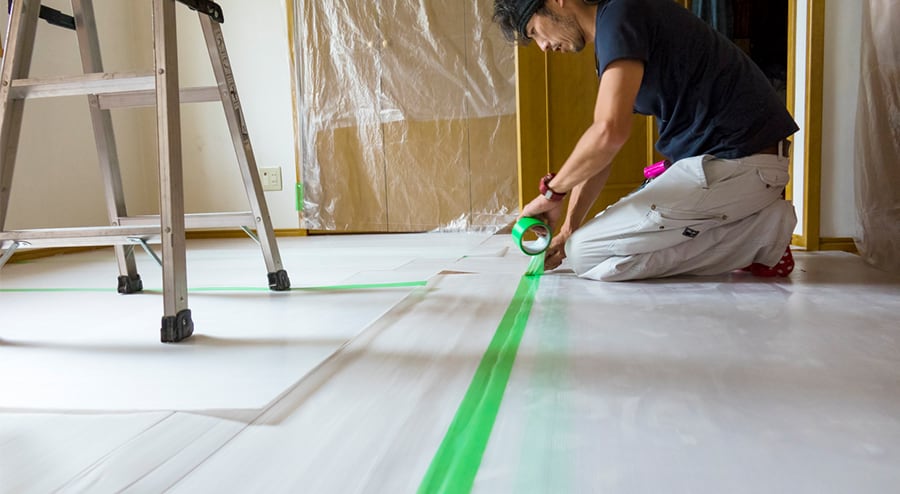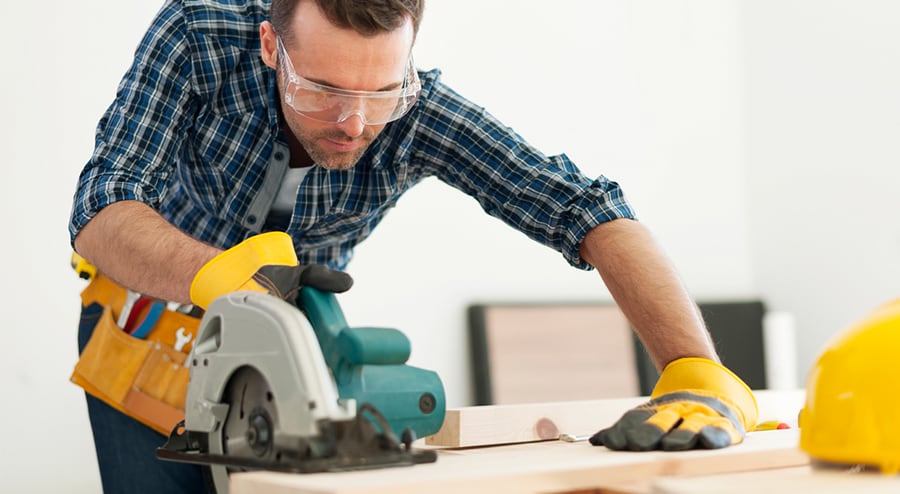Are you a weekend warrior who’s determined to up your home’s resale value all by yourself, one Saturday at a time? If so, you’re not alone. According to the Chicago Tribune, home improvement enthusiasts just like you spend upwards of $40 billion a year in materials and supplies to upgrade their homes. It’s a great way to save money and to foster valuable new skills.
Unfortunately, home improvement projects are also a good way to get hurt. While there are no centrally-collected statistics on home projects, a study on DIY-related deaths in Australia found that, on average, home projects were implicated in 75 deaths a year over a four-year period. That doesn’t sound like much, but if the same rate applied in the US, we’d be talking about a death nearly every day.
Working with ladders dramatically increases your risk of serious injury or death from a fall. Nail guns, power saws and radiant heaters all factor into the list of effective ways to mangle yourself, says the U.S. Consumer Product Safety Commission. So if you’ve heard all the disclaimers and are determined to go-it-alone regardless, take the following precautions to ensure your next home improvement project doesn’t become your last.
Exercise Caution Around Ladders
Approximately 90,000 people end up in the emergency room every year thanks to ladders, says the West Bend Insurance Company. If you’d rather not be one of them, avoid these four infamous mistakes:
- Choosing the wrong ladder for the job.
- Using a broken ladder.
- Using the right ladder incorrectly.
- Placing your ladder in the wrong spot.
Your ladder should always be positioned carefully, especially if you’re using the extension kind: improper placement can turn even the most structurally sound ladder into a hazard. Follow these rules:
- The rule of four: one of the clearest rules of thumb is that you should place the base of your ladder one foot from the wall or other surface for every four feet it rises above the ground. In other words, if you’re going to be working eight feet up, the base of your ladder should be back two feet.
- In placing a ladder, another good rule of thumb to find the correct angle is to see if you can wrap your hands around the nearest rung if you stand straight with your feet on the base and fully extend your arms. If the rung is closer, then you’ve got too steep an angle, and the ladder could tip. If the rung is farther away, you’ve got too shallow an angle, and the base could slide.
- Brace the feet of the ladder. This can be as easy as finding someone to hold it for you.
- Tie the top of your ladder to a solid, secure object, like an eyebolt inserted into the surface it’s leaning against.
Ladders dramatically increase your risk of falls. Use them with care.
The Basics
Ladders are a big hazard when doing a do-it-yourself project, but no matter what home improvement activity you engage in, you should take account of some basic safety precautions.
- Use protective eyewear. Even if you’re not doing something that presents an obvious risk to your eyes, safety glasses and goggles will help prevent the usual debris, dust, and other irritants that a project can create from getting your your eye.
- Wear gloves. For all the same reasons you should protect your eyes, you should wear sturdy work gloves even if you don’t see any obvious hazard. And if you’re working with hazardous chemicals—even paint—consider wearing specialized gloves as well.
- Use earplugs. If you’re using a loud power tool, you can permanently damage your ears.
- Have adequate lighting. Especially if you’re working in an enclosed space or out of daylight hours, bring in lamps to make sure you can see what you’re doing.
- Give yourself room to work in. Sometimes you have to work around obstacles and clutter, but if you can move anything out of your way, do so. And if possible, take steps to prevent children, pets, or other surprise visitors from entering the room where you’re working.
- Keep your workspace clean, and clean up after yourself. Keep debris off the floor where it can cause you to trip or slip. Sweeping or vacuuming sawdust periodically can prevent it from getting into your eyes. And avoid leaving power tools, hand tools, and volatile chemicals out where children can access them.
Take Care With Power Tools
Power tools are another infamous culprit when it comes to home-improvement injuries. Including professional use, power tools cause more than 124,000 injuries every year. To use them safely, keep a few precautions in mind, like these recommended by the Power Tool Institute:
- Always wear personal protective equipment, or PPE. For most power tools, this includes eye and hearing protection and a dust mask.
- Make sure your tool is powered down before plugging it in.
- Do a visual inspection to make sure all guards are in place.
- Don’t overreach or rush to get finished.
- Make sure any tool you use is in good working condition, and use the right tool for the job.
By making certain jobs easier, power tools can make your project safer. But only if you use them correctly.
Check and Recheck Electrical Work
Electrical hazards are everywhere when it comes to home improvement projects. It might look like a simple enough task to replace a burned-out outlet or to switch out those dated porch lights, but unless you know a thing or two about working with electricity, you could be in for the shock of your life. If you’re determined to give it a go regardless, use the following precautions:
- Turn off the main breaker and make sure everyone in the home knows to leave it off. Tape up a sign if necessary.
- Use a voltage meter to double check that no current is running.
- Use insulated tools designed specifically for electrical work.
- Avoid using aluminum or steel ladders when working with electricity.
- Wear rubber gloves and goggles.
- Avoid plugging power tools into extension cords if possible. If an extension cord is necessary, make sure it’s heavy duty enough to handle the tool.
Electrical work is not to be undertaken lightly—even when it’s done correctly, it can be difficult, if not impossible, for amateurs to pass a safety inspection or file the proper paperwork. And if something bad does happen, like a fire, amateur electrical work can void your homeowner’s insurance. So think twice before taking on an electrical home improvement project yourself.
Follow the Instructions
If you plan on doing a home improvement project, it pays to plan carefully and to familiarize yourself with what you’ll be doing beforehand. Consider the following:
- Do you have a plan? Coming up with an orderly schedule of how to tackle a task can save a lot of trouble. If you’re replacing your cabinets, for example, you’ll make sure you’ve done everything you need to ahead of time—getting the right tools, for example, and having the right materials on hand—before you remove your current cabinets.
- Do you have clear instructions? Go over whatever instructions you’re using for the project and make sure you understand every step. If you have questions, you may be able to find a visual guide or a video online.
- Have you spoken with someone who has first-hand experience with this kind of work? It’s also a good idea to talk beforehand to people who have done the job you’re considering, or something similar in the past. What challenges did they face? What surprised them along the way? Do they have any shortcuts or other suggestions for making the job easier?
How to Tell If a Job’s Too Difficult
As you go over the instructions, you’ll also want to look out for clear signals that the job you’re considering may be too much for you. Reconsider your project if:
- You have real trouble understanding the directions.
- You suspect you may not have time to complete the job without taking due care or if leaving it unfinished would create a hazardous area in your home.
- Even if you follow the instructions, there’s still a risk of you hurting yourself badly—or seriously damaging your property—if some unforeseen accident happens.
Some More Resources
Ready to jump into your project now? Great. As you plan, prepare, and work, here are some useful sites for instructions, support, and community.
- AcmeHowTo.com publishes a series of do-it-yourself guides, including one targeted toward electrical work, to help you navigate the world of home repair. They’re available online for free.
- Familyhandyman.com is run by the Reader’s Digest association, and has an exhaustive assortment of guides to home improvement projects.
- Similar to Family Handyman, doityourself.com offers a wealth of photo-supplemented guides for taking on home projects.
DIYers save millions of dollars—and gain wagon loads of self-esteem—each year by going it alone, but it’s important to recognize exactly how far an entrepreneurial spirit can carry you. If you think you’re in danger of venturing too far outside your skill sets when it comes time to add on that spare bedroom or to finish that basement, ask for help. Your willingness to do it right will pay for itself in the long run.



